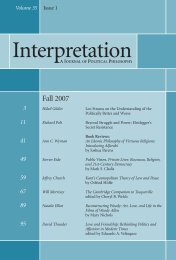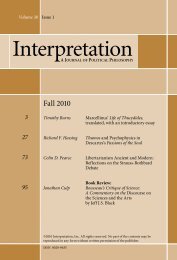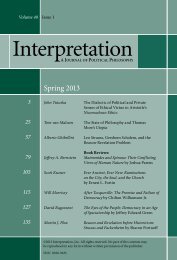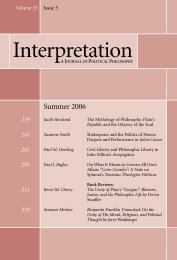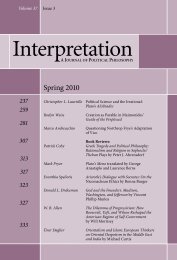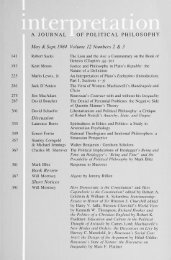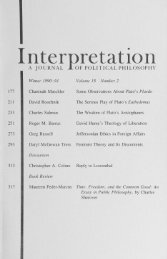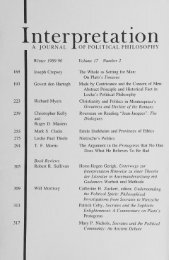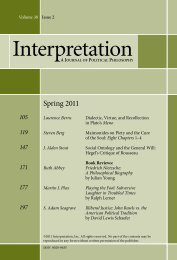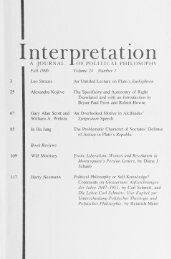Teaching and the Decline of Liberty at Credulity and Curiosity in A ...
Teaching and the Decline of Liberty at Credulity and Curiosity in A ...
Teaching and the Decline of Liberty at Credulity and Curiosity in A ...
Create successful ePaper yourself
Turn your PDF publications into a flip-book with our unique Google optimized e-Paper software.
Man <strong>and</strong> N<strong>at</strong>ure <strong>in</strong> Pl<strong>at</strong>o's Phaedo 169<br />
ongo<strong>in</strong>g <strong>in</strong>vestig<strong>at</strong>ion, <strong>the</strong> question takes <strong>the</strong> form <strong>of</strong> an <strong>in</strong>quiry <strong>in</strong>to <strong>the</strong> "collect-<br />
edness"<br />
<strong>of</strong> soul. The n<strong>at</strong>ure <strong>and</strong> recollection arguments did not prove th<strong>at</strong> our<br />
toge<strong>the</strong>r"<br />
own souls exist, each still "ga<strong>the</strong>red after de<strong>at</strong>h (a third requirement <strong>in</strong><br />
Cebes'<br />
<strong>in</strong>itial objection to Socr<strong>at</strong>es'<br />
70a-b) apology, <strong>and</strong> for all time nor is <strong>the</strong>re<br />
any pro<strong>of</strong> th<strong>at</strong> <strong>the</strong> soul can exist <strong>in</strong> complete separ<strong>at</strong>ion from <strong>the</strong> body, quite <strong>the</strong><br />
opposite <strong>in</strong> fact. When Simmias now wishes Socr<strong>at</strong>es to show <strong>in</strong> addition th<strong>at</strong> <strong>the</strong><br />
soul is not sc<strong>at</strong>tered after de<strong>at</strong>h, Socr<strong>at</strong>es says th<strong>at</strong> <strong>the</strong>y require a charm to charm<br />
away <strong>the</strong>ir fear <strong>of</strong> de<strong>at</strong>h (77c). Thus <strong>the</strong> last argument th<strong>at</strong> <strong>the</strong> soul is noncom<br />
posite <strong>and</strong> <strong>the</strong>refore unable to disperse <strong>at</strong> de<strong>at</strong>h is <strong>of</strong> a questionable character,<br />
charm be<strong>in</strong>g l<strong>in</strong>ked with myth (ii4d) <strong>and</strong> myths with <strong>the</strong> poets,<br />
myths, not arguments (Adyoi) (61b).<br />
who compose<br />
At <strong>the</strong> end <strong>of</strong> <strong>the</strong> recollection argument, Simmias suggests th<strong>at</strong> <strong>the</strong> soul, hav<br />
<strong>in</strong>g been put toge<strong>the</strong>r from some o<strong>the</strong>r source, might simply disb<strong>and</strong> aga<strong>in</strong> <strong>at</strong><br />
de<strong>at</strong>h. Socr<strong>at</strong>es does not proceed by argu<strong>in</strong>g th<strong>at</strong> each <strong>in</strong>dividual soul rema<strong>in</strong>s<br />
ga<strong>the</strong>red toge<strong>the</strong>r after de<strong>at</strong>h, as Simmias <strong>in</strong>tim<strong>at</strong>es he might; <strong>in</strong>stead he argues<br />
th<strong>at</strong> <strong>the</strong> soul is not composite <strong>and</strong> for this reason unlikely to disperse. He sets up<br />
a dichotomy which is alien to <strong>the</strong> two previous arguments, but which is comp<strong>at</strong>i<br />
ble with <strong>the</strong> apology section. The world is divided <strong>in</strong>to two k<strong>in</strong>ds <strong>of</strong> be<strong>in</strong>g<br />
<strong>in</strong>visible, changeless, noetic, noncomposite, <strong>and</strong> visible, constantly chang<strong>in</strong>g,<br />
anoetic, composite. Socr<strong>at</strong>es gives a series <strong>of</strong> pro<strong>of</strong>s th<strong>at</strong> <strong>the</strong> soul fits <strong>in</strong>to <strong>the</strong> c<strong>at</strong><br />
egory <strong>of</strong> <strong>the</strong> noncomposite form <strong>of</strong> be<strong>in</strong>g. However,<br />
soon after he describes <strong>the</strong><br />
activities <strong>of</strong> various human souls, <strong>in</strong>clud<strong>in</strong>g philosophic souls, <strong>in</strong> such a way th<strong>at</strong><br />
<strong>the</strong> human soul appears to be a ga<strong>the</strong>red <strong>and</strong> ga<strong>the</strong>r<strong>in</strong>g type <strong>of</strong> be<strong>in</strong>g <strong>the</strong> philo<br />
sophic soul most <strong>of</strong> all (cf. 83a). Subtly <strong>and</strong> not so subtly, he undercuts his own<br />
argument th<strong>at</strong> <strong>the</strong> <strong>in</strong>dividual soul is noncomposite <strong>and</strong> not able to disperse.<br />
The process <strong>of</strong> mak<strong>in</strong>g <strong>the</strong> division between <strong>the</strong> two separ<strong>at</strong>e forms <strong>of</strong> be<strong>in</strong>g is<br />
complic<strong>at</strong>ed <strong>and</strong> conta<strong>in</strong>s many layers <strong>of</strong> hypo<strong>the</strong>ses, but <strong>the</strong> support<strong>in</strong>g argu<br />
ments <strong>the</strong>mselves are not fleshed out. After posit<strong>in</strong>g th<strong>at</strong> ;/ anyth<strong>in</strong>g happens to<br />
be noncomposite, <strong>the</strong>n th<strong>at</strong> th<strong>in</strong>g, // anyth<strong>in</strong>g,<br />
ought not undergo dispersion<br />
(78b-c), Socr<strong>at</strong>es turns, not directly to soul, but to wh<strong>at</strong> is apprehended by <strong>the</strong><br />
soul. The equal itself <strong>and</strong> <strong>the</strong> beautiful itself are said to be taken hold <strong>of</strong> only by<br />
<strong>the</strong> reason<strong>in</strong>g <strong>of</strong> <strong>the</strong> <strong>in</strong>tellect (79a); <strong>the</strong> role <strong>of</strong> sense perception is now denied<br />
(compare 74a-b). These <strong>in</strong>visible th<strong>in</strong>gs grasped by<br />
<strong>the</strong> soul are said to be<br />
changeless <strong>and</strong> mon<strong>of</strong>orm <strong>and</strong> <strong>the</strong> soul is said to be ak<strong>in</strong> to (but not <strong>the</strong> same as)<br />
<strong>the</strong>m. On <strong>the</strong> o<strong>the</strong>r h<strong>and</strong>, <strong>the</strong> visible, tangible th<strong>in</strong>gs, such as men, horses or<br />
cloaks,4<br />
which may be called equal or beautiful, are claimed to be constantly<br />
chang<strong>in</strong>g <strong>and</strong> never <strong>in</strong> any way like each o<strong>the</strong>r or <strong>the</strong>mselves (78e-79a). Soc<br />
r<strong>at</strong>es ignores <strong>the</strong> likeness between members <strong>of</strong> a species th<strong>at</strong> allows <strong>the</strong>m to be<br />
4. Socr<strong>at</strong>es uses comb<strong>in</strong><strong>at</strong>ions <strong>of</strong> a cloak, lyre, horses, <strong>and</strong> human be<strong>in</strong>gs, <strong>and</strong> pictures <strong>of</strong> <strong>the</strong>se<br />
th<strong>in</strong>gs, as illustr<strong>at</strong>ions <strong>in</strong> <strong>the</strong> recollection <strong>and</strong> noncomposite soul arguments (73d-74a, 78e). The lyre<br />
<strong>and</strong> cloak anticip<strong>at</strong>e images <strong>of</strong> soul th<strong>at</strong> Simmias <strong>and</strong> Cebes will l<strong>at</strong>er use, but <strong>the</strong> horses draw our <strong>at</strong><br />
tention to ano<strong>the</strong>r dialogue, <strong>the</strong> Phaedrus,<br />
with its important discussion <strong>of</strong> soul. In <strong>the</strong> Phaedrus, <strong>the</strong><br />
powers, or desires, <strong>of</strong> <strong>the</strong> composite human soul are likened to two horses <strong>and</strong> a charioteer.



